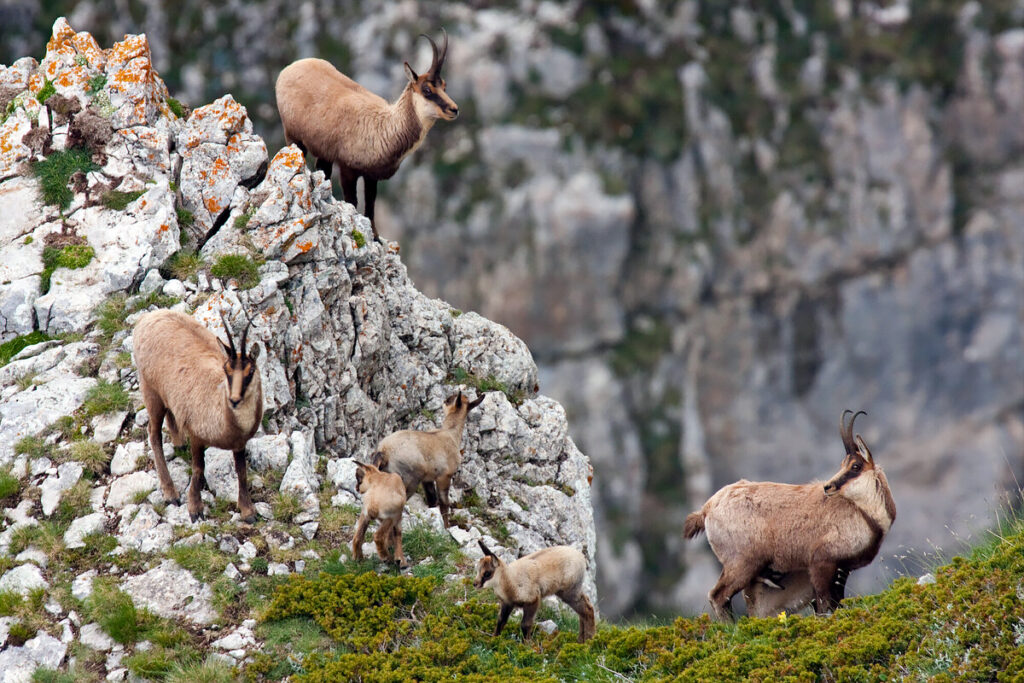Four Apennine chamois were released into the Sirente Velino Regional Park in mid-May. This will enhance the existing free-roaming population and boost efforts to secure a long-term future for this iconic species.

Towards a wilder Apennines
Rewilding Europe is delighted to announce that four Apennine chamois – two adult males and two yearlings – were released into the Sirente Massif, in the Central Apennines rewilding landscape in Italy, in mid-May. The release, which was made possible by funding from French philanthropic foundation Fondation Ensemble, was carried out by personnel from the Sirente Velino Regional Park, together with the veterinarian Luca Tomei and team members and volunteers of Rewilding Apennines and Salviamo l’Orso (a local Italian NGO partner). They will join a population of more than 60 Apennine chamois that have already been reintroduced on the mountain, which is part of the park.
“This release, which is the first of many that will be carried out, is a step towards a more secure future for this beautiful and important keystone species,” says Mario Cipollone, Rewilding Apennines Team Leader. “The Apennine chamois is an important part of local food webs and helps to enhance biodiversity through its grazing, so this release is also a step toward a wilder Central Apennines.”
An endangered icon
The chamois is a species of agile goat-antelope native to many European mountain ranges. The Apennine chamois (Rupicapra pyrenaica ornata), a subspecies, was once found across the high-altitude landscapes of central and southern Italy, but habitat loss and hunting reduced its range until it was confined to just the Abruzzo, Lazio and Molise National Park. Despite reintroductions in several areas since then, the current population of around 3000 animals remains endangered, particularly as its genetic diversity is low.
The first Apennine chamois were reintroduced into the Sirente Massif in 2013, with individuals coming from the Maiella National Park and the Gran Sasso and Monti della Laga National Park (as part of a LIFE initiative). From 2014 to 2021, the births of 66 chamois have been confirmed on the Massif, with monitoring of the newly reintroduced population ongoing.
“Rewilding Apennines’ support for chamois conservation in the Apennines is important and we thank them for their commitment,” says Paola Morini, a biologist employed by the Sirente Velino Regional Park. “It has been a long journey to reach the point where we are today. Efforts to monitor the animals and to determine their behaviour and population trends are still critical.”

Keeping track
The two adult chamois that have just been released have been fitted with GPS collars. This will help park personnel and the Rewilding Apennines team monitor their movement and behaviour, which in turn improves future decision-making related to their conservation. Helping to monitor the animals is Claudia Brunetti, who joined the Rewilding Apennines team at the end of May as Chamois Field Officer. In her new position, which has also been enabled by the Fondation Ensemble grant, Claudia will work on monitoring, species protection, and community outreach.
“The information gained from the collars will give us new insight into the lives of the chamois,” she explains. “We will be able to see which areas they are using, and how that relates to vegetation and other aspects of their habitat. We can also see whether their behaviour and movement vary with age and sex, as we already know there are differences between males and females. The collars will also provide valuable data on mortality rates, and whether human-related activities, such as tourism and grazing by livestock, have an impact on their behaviour.”

Further releases
The chamois that were released in mid-May were kept in a large enclosure at the Chamois Visitor Centre and Wildlife Area, which is located in the village of Rovere, inside the Sirente Velino Regional Park. The release of at least two more chamois from this enclosure is expected to happen later this year (depending on when they are caught). These animals will be fitted with collars supplied by the Rewilding Apennines team.
It is hoped that as the chamois population on the Sirente Massif continues to grow and explore it will naturally recolonise the adjoining Velino Massif. The two mountain ranges are both protected within the Sirente Velino Regional Park.
“According to the behaviour of the species we hope to have a spillover of chamois from the Sirente to Velino mountain ranges in the future,” says Mario Cipollone. “There is a valley they will need to cross, which is a challenge, but maybe in winter when there is heavy snow they will do it.”

